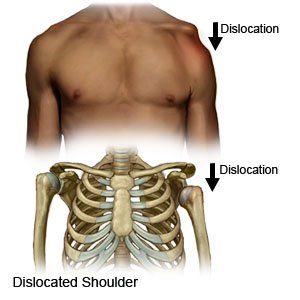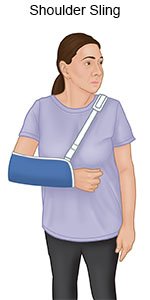Shoulder Dislocation
Medically reviewed by Drugs.com. Last updated on Apr 6, 2025.
A shoulder dislocation happens when the top of your arm bone (humerus) moves out of the socket in your shoulder blade.
 |
DISCHARGE INSTRUCTIONS:
Return to the emergency department if:
- Your shoulder and arm become pale or cold.
- You cannot move your shoulder and arm.
- You have more redness or swelling in your shoulder.
- Your shoulder becomes dislocated again.
Call your doctor if:
- You have a fever.
- You have more pain in your shoulder and arm even after you rest and take your medicine.
- You have new weakness or numbness in your shoulder and arm.
- You have questions or concerns about your condition or care.
Medicines:
You may need any of the following:
- Prescription pain medicine may be given. Ask your healthcare provider how to take this medicine safely. Some prescription pain medicines contain acetaminophen. Do not take other medicines that contain acetaminophen without talking to your healthcare provider. Too much acetaminophen may cause liver damage. Prescription pain medicine may cause constipation. Ask your healthcare provider how to prevent or treat constipation.
- A muscle relaxer may help the tight muscles in your shoulder relax.
- Take your medicine as directed. Contact your healthcare provider if you think your medicine is not helping or if you have side effects. Tell your provider if you are allergic to any medicine. Keep a list of the medicines, vitamins, and herbs you take. Include the amounts, and when and why you take them. Bring the list or the pill bottles to follow-up visits. Carry your medicine list with you in case of an emergency.
Rest your shoulder and arm:
Rest helps your muscles and tissues heal. Avoid activities that cause pain or use an overhead arm motion. Your healthcare provider will tell you when it is safe to return to sports or other daily activities.
How to wear a brace, sling, or splint:
A brace, sling, or splint may be needed to limit your movement and protect your shoulder.
 |
- Wear your brace, sling, or splint all the time. Take it off only to bathe or do exercises as directed. Ask your healthcare provider how many weeks you should wear it.
- Keep your skin clean and dry. Place padding under your armpit to help absorb sweat and prevent sores on your skin.
- Do not hunch your shoulders. This may cause pain. Keep your shoulders relaxed.
- Support your wrist and hand with the sling. Cover the knuckles on your hand with your sling. Your wrist should be positioned higher than your elbow. Your wrist may start to hurt or go numb if your sling is too short.
Apply ice:
Ice helps decrease swelling and pain. Ice may also help prevent tissue damage. Use an ice pack, or put crushed ice in a plastic bag. Cover it with a towel before you place it on your shoulder. Apply ice for 15 to 20 minutes every hour or as directed.
Exercises:
Begin gentle exercises as directed. After healing begins, you may start light exercises so your shoulder does not get stiff. Go to physical therapy if directed. A physical therapist teaches you exercises to help improve movement and strength, and to decrease pain. Do not lift heavy objects or do any exercise that causes severe pain.
Follow up with your doctor in 5 to 10 days:
Write down your questions so you remember to ask them during your visits.
© Copyright Merative 2025 Information is for End User's use only and may not be sold, redistributed or otherwise used for commercial purposes.
The above information is an educational aid only. It is not intended as medical advice for individual conditions or treatments. Talk to your doctor, nurse or pharmacist before following any medical regimen to see if it is safe and effective for you.
Learn more about Shoulder Dislocation
Care guides
Further information
Always consult your healthcare provider to ensure the information displayed on this page applies to your personal circumstances.
